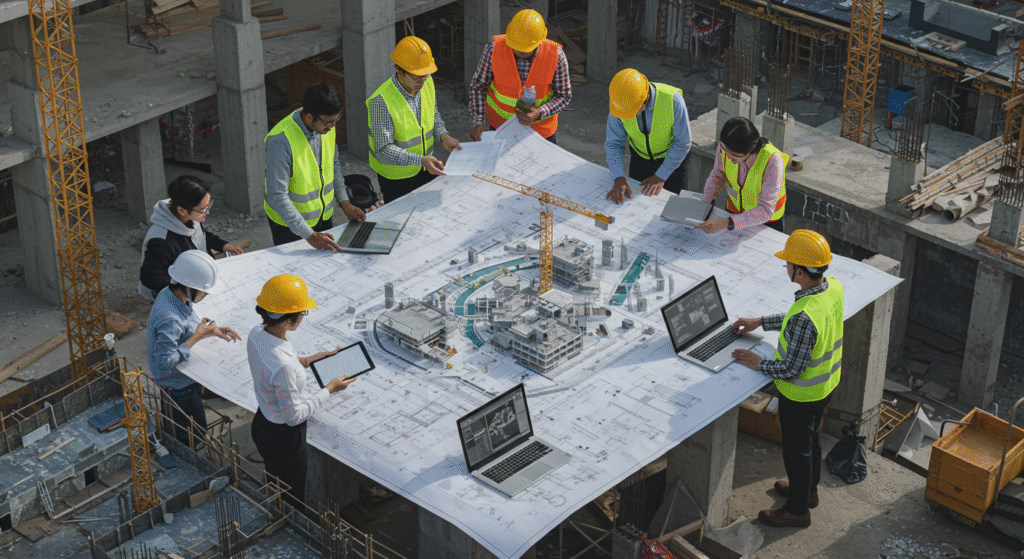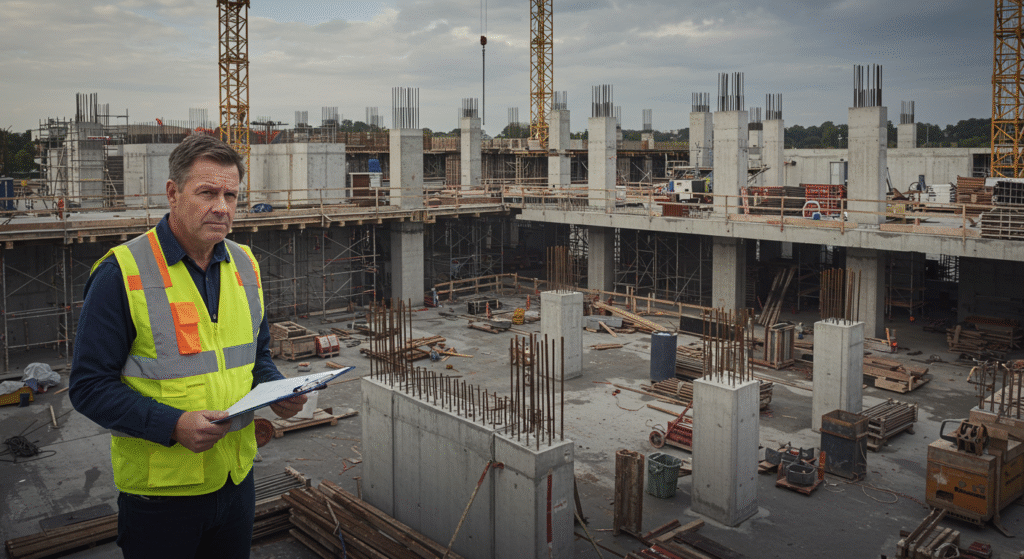Construction Project Management: A Comprehensive Guide

Construction Project Management
Table of Contents
- Introduction to Construction Project Management
- 1.1. Definition and Scope
- 1.2. Importance in the Construction Industry
- 1.3. Historical Development
- Key Phases of Construction Project Management
- 2.1. Project Initiation and Planning
- 2.2. Project Scheduling and Timelines
- 2.3. Budgeting and Cost Management
- 2.4. Risk Management and Mitigation
- Tools and Techniques in Construction Project Management
- 3.1. Project Management Software
- 3.2. Scheduling Tools and Techniques
- 3.3. Budgeting and Cost Estimation Tools
- 3.4. Risk Management Tools and Techniques
- Quality Control and Assurance in Construction
- 4.1. Importance of Quality in Construction
- 4.2. Quality Control Processes
- 4.3. Quality Assurance Practices
- 4.4. Tools and Techniques for Quality Management
- Communication and Stakeholder Management
- 5.1. Effective Communication Strategies
- 5.2. Stakeholder Identification and Analysis
- 5.3. Stakeholder Engagement and Management
- 5.4. Conflict Resolution and Negotiation
- Leadership and Team Management
- 6.1. Leadership Styles in Project Management
- 6.2. Building and Managing High-Performing Teams
- 6.3. Motivation and Empowerment of Team Members
- 6.4. Conflict Resolution and Team Dynamics
- Sustainability and Environmental Considerations
- 7.1. Sustainable Construction Practices
- 7.2. Environmental Impact Assessment
- 7.3. Green Building and LEED Certification
- 7.4. Waste Management and Recycling
- Case Studies and Real-World Applications
- 8.1. Successful Construction Projects
- 8.2. Lessons Learned from Project Failures
- 8.3. Industry-Specific Applications
- 8.4. Global Infrastructure Initiatives
- Challenges and Future Trends in Construction Project Management
- 9.1. Emerging Technologies and Innovations
- 9.2. The Role of BIM and Digital Twins
- 9.3. The Impact of Climate Change and Sustainability
- 9.4. The Importance of International Collaboration
- Conclusion
- 10.1. Summary of Key Points
- 10.2. The Evolving Role of Construction Project Management
- 10.3. Encouragement for Future Project Managers
1. Introduction to Construction Project Management

1.1. Definition and Scope
Construction Project Management involves the planning, organizing, and controlling of construction projects to achieve specific goals. It encompasses all aspects of the project, from initial conception to final delivery, ensuring that the project is completed on time, within budget, and to the required quality standards.
1.2. Importance in the Construction Industry
Effective Construction Project Management is crucial for the success of construction projects. It ensures that resources are used efficiently, risks are mitigated, and the final product meets the expectations of all stakeholders. Good project management also enhances the reputation of construction firms and contributes to the overall growth of the industry.
1.3. Historical Development
The history of Construction Project Management dates back to ancient times, with early projects like the Pyramids of Giza and the Great Wall of China demonstrating the need for organized planning and management. Over the centuries, the field has evolved with the development of new technologies, methodologies, and standards.
2. Key Phases of Construction Project Management
2.1. Project Initiation and Planning
The project initiation phase involves defining the project scope, identifying stakeholders, and developing a project charter. Planning includes setting objectives, defining deliverables, and creating a detailed project plan.
2.2. Project Scheduling and Timelines
Developing a project schedule involves creating a timeline that outlines the start and end dates of each project phase. Tools like Gantt charts and critical path analysis are used to manage project timelines effectively.
2.3. Budgeting and Cost Management
Budgeting involves estimating the total cost of the project and allocating funds to each phase. Cost management ensures that the project is completed within the approved budget by monitoring and controlling expenditures.
2.4. Risk Management and Mitigation
Risk Management involves identifying potential risks, assessing their impact, and developing strategies to mitigate them. This ensures that the project is not derailed by unforeseen events or circumstances.
3. Tools and Techniques in Construction Project Management

3.1. Project Management Software
Project Management Software like Microsoft Project, Primavera P6, and Asana are essential tools for managing construction projects. They help in planning, scheduling, budgeting, and tracking project progress.
3.2. Scheduling Tools and Techniques
Scheduling tools like Gantt charts, critical path method (CPM), and program evaluation and review technique (PERT) are used to create and manage project timelines.
3.3. Budgeting and Cost Estimation Tools
Budgeting tools like cost-benefit analysis, earned value management (EVM), and cost estimation software help in managing project finances effectively.
3.4. Risk Management Tools and Techniques
Risk Management tools like SWOT analysis, decision trees, and Monte Carlo simulations are used to identify and mitigate risks in construction projects.
4. Quality Control and Assurance in Construction
4.1. Importance of Quality in Construction
Quality control and assurance are essential in construction to ensure that the final product meets the required standards and specifications. It ensures the safety, durability, and performance of the infrastructure.
4.2. Quality Control Processes
Quality control processes involve regular inspections, testing, and audits to ensure that the project meets the required quality standards. It also involves corrective actions to address any defects or deficiencies.
4.3. Quality Assurance Practices
Quality assurance involves the implementation of quality management systems and processes to ensure that the project is designed and constructed to meet the required standards.
4.4. Tools and Techniques for Quality Management
Tools like checklists, control charts, and defect tracking software are used to manage quality in construction projects.
5. Communication and Stakeholder Management

5.1. Effective Communication Strategies
Effective communication is crucial for the success of any project. It involves clear and timely communication with all stakeholders, including team members, clients, and end-users.
5.2. Stakeholder Identification and Analysis
Stakeholder identification and analysis involve identifying all individuals and groups affected by the project and assessing their interests, needs, and influence.
5.3. Stakeholder Engagement and Management
Stakeholder engagement involves keeping stakeholders informed and involved throughout the project lifecycle. It ensures that their needs and expectations are met and that they are satisfied with the project outcome.
5.4. Conflict Resolution and Negotiation
Conflict resolution and negotiation are essential skills for project managers to manage disagreements and disputes that may arise during the project.
6. Leadership and Team Management
6.1. Leadership Styles in Project Management
Different leadership styles like autocratic, democratic, and transformational leadership can be used in project management to motivate and direct team members.
6.2. Building and Managing High-Performing Teams
Building and managing high-performing teams involves selecting the right team members, defining roles and responsibilities, and fostering a positive team culture.
6.3. Motivation and Empowerment of Team Members
Motivating and empowering team members involves providing them with the necessary resources, support, and autonomy to perform their tasks effectively.
6.4. Conflict Resolution and Team Dynamics
Conflict resolution and team dynamics involve managing interpersonal relationships and resolving conflicts to maintain a positive and productive team environment.
7. Sustainability and Environmental Considerations

7.1. Sustainable Construction Practices
Sustainable construction practices involve designing and constructing projects that minimize environmental impact and promote sustainability.
7.2. Environmental Impact Assessment
Environmental impact assessment involves evaluating the potential environmental effects of a project and developing strategies to mitigate them.
7.3. Green Building and LEED Certification
Green building practices and LEED certification involve designing and constructing buildings that are environmentally responsible and sustainable.
7.4. Waste Management and Recycling
Waste management and recycling involve minimizing waste generation and reusing or recycling materials to reduce the environmental impact of the project.
8. Case Studies and Real-World Applications
8.1. Successful Construction Projects
Case studies of successful construction projects provide insights into effective project management practices and strategies.
8.2. Lessons Learned from Project Failures
Analyzing project failures provides valuable lessons on what went wrong and how to avoid similar mistakes in future projects.
8.3. Industry-Specific Applications
Construction project management is applied across various industries, each with its own unique challenges and requirements.
8.4. Global Infrastructure Initiatives
Global infrastructure initiatives like the Belt and Road Initiative demonstrate the importance of effective project management in delivering large-scale construction projects.
9. Challenges and Future Trends in Construction Project Management

9.1. Emerging Technologies and Innovations
Emerging technologies like Building Information Modeling (BIM), artificial intelligence (AI), and the Internet of Things (IoT) are transforming the field of construction project management.
9.2. The Role of BIM and Digital Twins
BIM and digital twins are revolutionizing the way construction projects are designed, constructed, and managed. They provide a digital representation of the project that can be used for planning, simulation, and analysis.
9.3. The Impact of Climate Change and Sustainability
Climate change and sustainability are becoming increasingly important considerations in construction project management. Project managers must develop strategies to mitigate the impact of projects on the environment and promote sustainability.
9.4. The Importance of International Collaboration
International collaboration is essential for delivering large-scale construction projects that span multiple countries and regions. It involves working with diverse teams, understanding different cultures and regulations, and managing cross-border logistics.
10. Conclusion

10.1. Summary of Key Points
Construction Project Management is a complex and multifaceted discipline that requires careful planning, effective leadership, and a commitment to quality and sustainability. By understanding the key phases, tools, and techniques involved in project management, construction professionals can deliver successful projects that meet the needs of society.
10.2. The Evolving Role of Construction Project Management
The role of construction project management is constantly evolving, driven by emerging technologies, changing regulations, and increasing demands for sustainability. As the field continues to grow and develop, project managers must stay ahead of the curve by embracing new tools, techniques, and practices.
10.3. Encouragement for Future Project Managers
For those considering a career in construction project management, the field offers immense opportunities to make a meaningful impact on society. By developing strong project management skills, staying current with industry trends, and committing to continuous learning, future professionals can successfully navigate the challenges and opportunities of this dynamic field.
Pingback: Engineering Innovation for Communities
Pingback: Transportation Network Engineering: A Comprehensive Overview